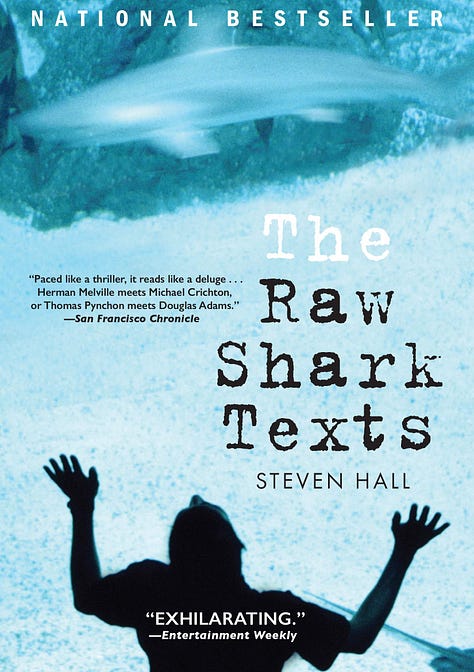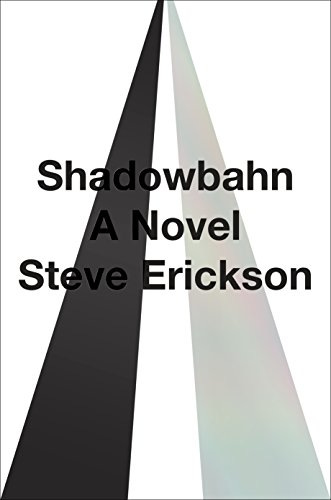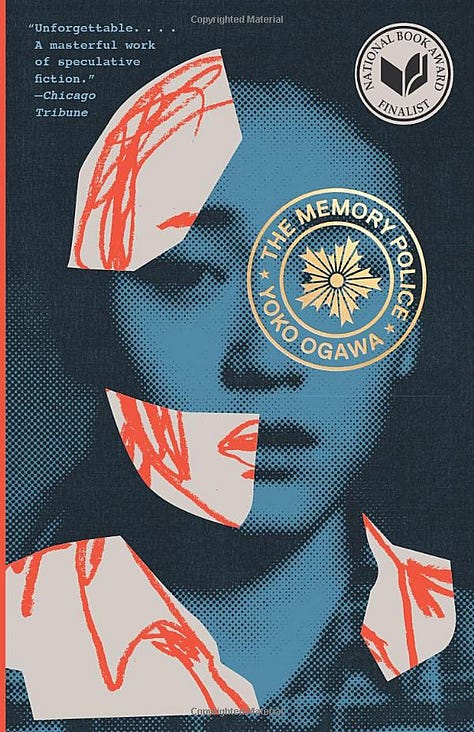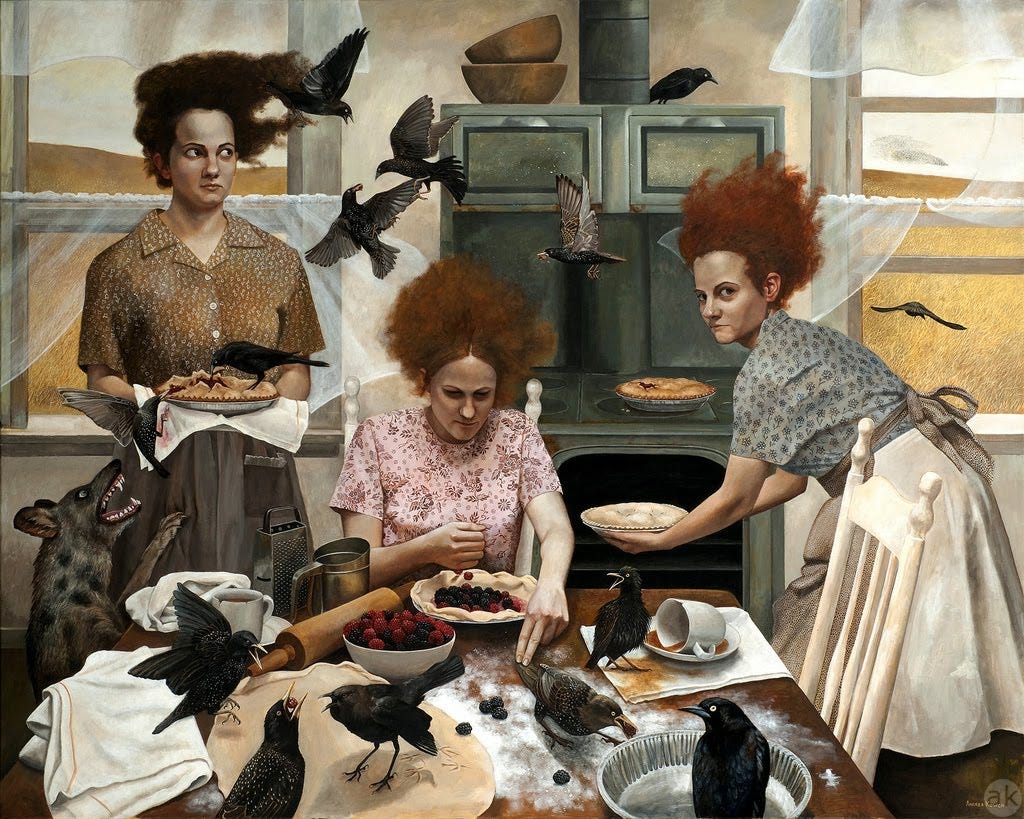“The Visitors” by Andrea Kowch1
Every morning when I open my email, I see evidence that a few more of you have subscribed or followed, which helps vanquish the fear that I’m just one more old guy howling at the moon. How can I possibly repay you? By not giving you drivel, cliché, contentless content, and so on. My goal is to not waste your time. To you all, thanks for dropping in.
1. WHAT SLIPSTREAM IS:
Originally, the word meant:
a stream of fluid (such as air or water) driven aft by a propeller—
an area of reduced air pressure and forward suction immediately behind a rapidly moving vehicle—
Over the past generation or two, Slipstream has become a literary category that refers to . . . actually, it’s a bit fluid. Within the big tent called Speculative Lit you find an unholy mob of genres, subgenres, sub-subgenres2 that have in common only not being traditional realism.
Let’s let AI’s take a stab at defining it:
A literary genre that blends elements of science fiction, fantasy, and literary fiction, often pushing the boundaries of conventional narrative structures, creating a sense of strangeness by making the familiar seem uncanny or vice versa; it's considered a "borderland" genre that doesn't fully fit into any one category, often described as "the fiction of strangeness.”
Key points about slipstream fiction:
Blending genres: It combines elements from different genres like sci-fi, fantasy, and literary fiction, creating a unique hybrid.
Unconventional narrative: Slipstream stories often break from traditional storytelling structures, playing with time, space, and reality in unexpected ways.
Sense of the strange: The defining characteristic is a feeling of unsettling strangeness or disorientation, where the familiar is presented in a distorted or unsettling light.
Origin of the term:
The term "slipstream" is credited to author Bruce Sterling3, referring to a space that sits between established genres.
[Generative AI from Google.]
2. SLIPSTREAM & ME:
Long-time followers know my weakness for dystopian/post-apoc offerings, especially cli-fi, the coolest new kid on the block:
Yet, I wasn’t a kid who lost himself in the sci-fi multiverse—as I became a serious reader in my teens, my literary snobbishness walled me off from the stuff. Only in my late twenties did I come around to the idea that sci-fi wasn’t, in fact, low-brow crap.4
I’ve picked away at the classics since then, but I’m still a dabbler (and definitely no scholar of sci-fi). Just an occasional reader of speculative-lit, with my own tastes/affinities—as I said, cli-fi, post-apocalyptica, cyberpunk, steampunk—as well as my blind spots (most fantasy, horror5).
At heart, I’m still a literary-fiction reader. I love realism. I revere novels that depict the world’s physicality, the actualness of fact and object and interaction, novels that steep you in moments of life as it’s lived.
A handful of my favorites listed here6.
But today’s post is about books that . . . I was gonna say eschew realism, but do you really want to listen to a guy who’d use such an icky word? I think not. Also, Slipstream is realistic . . . until it’s not. In short, Slipstream messes with you.
Which brings us to the question: Why do we like being messed with?
Below, I’ll mention some speculative books in the sci-fi camp, and others that show how slipstream differs. But, first, let’s unpack “being messed with” a bit more. It sounds trite to say books transport us . . . and yet that’s the basic thing, isn’t it? To be plucked out of the here-and-now, and plopped down somewhere else? Years ago, William Gass’s, Fiction and the Figures of Life, deposited in me a handful of insights I still consider fundamental7—one concerns this “somewhere else” (or you could call it otherness). Here’s what Gass wrote:
We are so pathetically eager for this other life, for the sounds of distant cities and the sea; we long . . . to pit ourselves against some trying wind, to follow the fortunes of a ship hard beset, to face up to murder and fornication, and the somber results of anger and love; oh, yes, to face up—in books . . .
Fiction is about how regular life, business-as-usual, is interrupted by happens-only-once. That’s what stories are. When we start into a new book, our brains are on high alert, listening for some version of: Ordinarily . . . but today . . . So the first answer to the question,Why do we like being messed with? is: all good stories mess with us—it’s in their contract, the bargain we agreed to: we give them our time, they give us a dose of otherness.
A second answer might begin: If we read for multiple reasons—to learn, to have companionship, to get vicariously what we can’t get IRL, to temporarily gag the other voices (inner and outer) that jabber at us, to re-affirm that we belong in the cohort of serious readers, and so on—these motivations, these cravings, sort out differently, reader to reader. Our reading hunger is personal, a more or less unique mosaic . . . which, I think, is why a given novel can be perceived so divergently. One person’s ewww— (or meh—) can be another’s Oh, yes, more of that! Which is another way of saying: We like the way certain books align (or mess with) with our personal reading hunger.
3. SCI-FI vs. SLIPSTREAM:
Let’s start with a classic: The Time Machine, H. G. Wells (1895).
The Time Machine’s hero (known only as the Time Traveler) is a “gentleman scientist”—that is, a passionate aristocratic amateur.8 9
He constructs a machine that zips him thousands of years into the future, where he learns that humanity has evolved into two distinct species, the nubile Eloi and the monstrous underground-living Morlocks (the Eloi are the Morlocks’ livestock).
This is science fiction, a sort we now call steampunk.10 It’s dramatic, contains intellectual curiosity and invention. Like much of mid-20th C. sci-fi, it has a strong philosophical/socio-political/allegorical undercarriage. Wells was a socialist. The Morlocks are commonly said to represent the ultimate degradation of the working class under capitalism.
Besides Wells (who also wrote many “straight” novels), there was, of course, Jules Verne, but we tend to forget that speculative writing has deep roots [check out Christine de Pizan (c.1364-1430), The Book of the City of Ladies], that the Victorian era had proto-science fiction works like Samuel Butler’s, Erewhon (1872) and Richard Jeffries’, After London (1885).
4. OTHER SPECULATIVE WRITING THAT’S NOT SLIPSTREAM
At the heart of speculative writing is the question, What-if—? Many of the works are, essentially, thought experiments. Alt-history is one common genre—scenarios that rework the outcomes of actual events. Two familiar examples: Philip K. Dick’s, The Man in the High Castle (1962)11 —the world order if Germany had won WWII—and Philip Roth’s, The Plot Against America (2004), in which Charles Lindbergh, representing the America First Party, defeats FDR in 1940 then signs a pact with the Nazis agreeing not to oppose their expansion in Europe, touching off waves of American antisemitism, as seen through the lens of one Jewish family. It’s my favorite among Roth’s novels.
Neither of these two novels is Slipstream (or sci-fi).
Some “thought experiment” novels are also formal experiments. For instance, these two slender “novels,” each a collections of brief pieces linked only by theme: Alan Lightman’s, Einstein’s Dreams (1993) [just like it sounds], and Italo Calvino’s, Invisible Cities (1972), a fantastical retelling of The Travels of Marco Polo.
And so on. The speculative lit room has many shelves.
If these aren’t Slipstream, what is? What’s the big difference?12
5. THE WTF FACTOR:
It’s strangeness.
But of a certain kind. The Time Traveler encounters strange human descendants and tries to understand who they are, and why. It’s a rational story, just as detective novels are deeply rational—the hero sorts an explanation out of the chaos, restores order.
But what of strangeness that can’t be “solved” or “understood”? What of strangeness that is woven into the fabric of the story? What of stories where the burden of understanding WTF’s going on falls not on a character, but on us?
Might as well jump in the deep end:
Below, four novels that come without handholds, that treat us like clothes in a dryer. Unlike “horror novels” that rub our noses in the macabre, these aren’t intended to scare us (if we are scared the fear’s a by-product), nor do they, really, want us to understand. They deal in confusion, bafflement, off-kilterness; they want us to feel that, to live inside that experience a while.
In the interest of avoiding spoilers, I’ll not say much about the individual stories. You may have already read one or more; if they’re unknown to you I urge you to check them out. I wager that scads of have readers thrown up their hands over these . . . but not you, loyal readers of the challenging.
House of Leaves, Mark Danielewski (2000)
The Unconsoled, Kazuo Ishiguro (1995)
Wittgenstein’s Mistress, David Markson (1988)13
Ice, Anna Kavan (1967)14
[I remember flying back across the country late at night, madly trying to finish the Ishiguro before we landed—not that I thought I’d get unconfused, that I’d find the key to the novel . . . I was just enthralled by the book’s audacity, wanting to hear what note it ended on.15



The novels (except for Borges, short-story master) are ones I’ve read and think will give you the best sense of what Slipstream does. Be sure to read The Memory Police—it’s much easier to hang onto, page by page, than the four cited above, and is a great example of how Slipstream gets under your skin.
A Shelf of Slipstream Novels:
The Man Who Saw Everything, Deborah Levy (2019)
Shadowbahn, Steve Erickson (2017)16
Exit West, Mohsin Hamid (2017)
Lincoln in the Bardo, George Saunders (2017)
The Bone Clocks, David Mitchell (2014)
The City & the City, China Miéville (2009)17
The Gone-Away World, Nick Harkaway (2008)18
The Raw Shark Texts, Steven Hall (2007)19
Explorers of the New Century, Magnus Mills (2005)20
Blindness, José Saramago (1995)
The Windup-Bird Chronicle, Haruki Murakami (1994)
The Memory Police, Yoko Ogawa (1994)21
Time’s Arrow, Martin Amis (1991)22
The Glamour, Christopher Priest (1984)23
Labyrinths [stories], Jorge Luis Borges (1964)
Pedro Páramo, Juan Rulfo (1955)
The Castle, Franz Kafka (1926)
Sheppard Lee: Written by Himself, Robert Bird Montgomery (1836)
The Reading Project/Challenge:
Spend a session looking at what others have to say about Slipstream (how they describe its method, its appeal, what distinguishes it from other speculative fiction). You’ll likely collect a bunch of examples along the way. Pick out at least two that appeal to you.
If you’ve kept track of your reading over time, scan the titles (otherwise, consult your memory). Now that you know what Slipstream is, do any of your past reads qualify?
The list below has twenty or so Slipstream titles I admire. Spend a session looking them up wherever you look books up, then pick (at least) five (they could be any of the ones I cited during this post), and they should include either Ice or The Unconsoled.
From these sources, read one Slipstream book each month for the next six months.
[Remember to let a loved one know your plans, in case a search party is required.]
Links:
https://en.wikipedia.org/wiki/Slipstream_fiction
https://best-sci-fi-books.com/19-best-slipstream-books/
https://thewritelife.com/slipstream-fiction/
https://electricliterature.com/oh-slippery-slipstream-who-is-the-weirdest-genre-of-them-all/
https://bookriot.com/what-is-slipstream/
https://bookriot.com/best-slipstream-books/
https://killzoneblog.com/2024/05/slipstream-a-unique-hybrid-fiction-cross-genre.html
https://www.apexbookcompany.com/a/blog/apex-magazine/post/the-radical-nature-of-slipstream-fiction
https://www.journalscape.com/jlundberg/page2
Andrea Kowch: Fantastic painter, tweaker of realism:
https://en.wikipedia.org/wiki/Andrea_Kowch
https://www.facebook.com/andrea.kowch.artist/
Genres, subgenres: Under “Science-fiction genres,” Wiki has 71 entries—from Afrofuturism, alien invasion, and alternate history to biopunk, cyberpunk, dieselpunk, hopepunk (and its flip side, grimdark), steampunk, and solar punk . . . to feminist science fiction, queer science fiction, multiverse, space opera, tech noir, transrealism, and widescreen baroque.
Bruce Sterling: First, two Wiki pages:
https://en.wikipedia.org/wiki/Bruce_Sterling
https://en.wikipedia.org/wiki/Bruce_Sterling_bibliography
Like a number of speculative fictionistas—William Gibson, Neal Stephenson, Kim Stanley Robinson and the legion of others—Sterling is deeply invested in the science/ideas surrounding the genre (many of the terms we routinely use today were coined by such practitioners—the word cyberspace, for instance, is generally attributed to Gibson; Robinson is associated with a futurism project based in San Francisco, The Long Now Foundation:
https://longnow.org/
I encourage you to have a look . . . the 10,000-Year Clock, the Bets and Predictions, etc.).
[How I know about this: One day I found myself remembering Stewart Brand, prime mover behind THE WHOLE EARTH CATALOG, wondered if he was still among the quick, discovered that he’d become the prime mover behind The Long Now. I continue to be amazed at how, among us, there are some outstanding minds, and how they’re sometimes coupled with uncommon personal energy and a let’s-get-this-done temperament. I touched on Brand in an earlier post.]
https://en.wikipedia.org/wiki/Whole_Earth_Catalog
Low-brow crap: Ditto for detective novels, some of which were fun to read! Didn’t rot the mind, after all. Ditto spy novels! . . . what if my literary prejudice had kept me from John le Carré? Jeez Louise!
Fantasy and horror: Not a LOTR fanboy, skipped GOT, but loved the first two of Mervyn Peake’s alt-fantasy Gormenghast novels: Titus Groan (1946) and Gormenghast (1950). And my Reading Back in Time Project led me to classics like Dracula and Frankenstein, and several Gothic novels—Ann Radcliffe’s The Italian (1797), for instance [her book The Mysteries of Udolpho (1794) is the commonly cited example of this genre [along with Horace Walpole’s The Castle of Otranto (1764)], wildly popular at the tail end of the 18th Century. Jane Austen aficionadas may remember the list of “seven horrid novels” she tucked into Northanger Abbey (1818):
The Castle of Wolfenbach [Eliza Parsons, 1793], The Necromancer [Lawrence Flammenberg, 1794], Horrid Mysteries [Carl Grosse, 1796], The Mysterious Warning [Eliza Parsons, 1796], Clermont [Regina Maria Roche, 1798], The Midnight Bell [Francis Lathom, 1798], and Orphan of the Rhine [Eleanor Sleath, 1798].
These novels later fell into such obscurity it was assumed Austen had invented them.
Realism:
Kairos, Jenny Erpenbeck (2021)
Normal People, Sally Rooney (2018)
Commonwealth, Ann Patchett (2016)
Eileen, Ottessa Moshfegh (2015)
All My Puny Sorrows, Miriam Toews (2014)
Winter’s Bone, Daniel Woodrell (2006)
The English Patient, Michael Ondaatje (1992)
Dinner at the Homesick Restaurant, Anne Tyler (1982)
Housekeeping, Marilynne Robinson (1981)
So Long, See You Tomorrow, William Maxwell (1980)
Gass: Long-time followers will have heard me cite Gass in prior posts. Here’s one more assertion of his that became bedrock for me:
In fiction, there is no such thing as description, there is only construction.
Meaning: even in a story drawn from “real life,” you’re responsible for making its world, choosing every word, integrating its elements, making it cohere, making a unique artifact. Yes, there’s serendipity, but having been serendipped you must decide: in or out?
This is akin to all my palaver about “Guernica” . . . here’s one of those earlier notes:
Late in my teaching life, I came to the thought that one quality we respond to in art is its saturation. I don’t know as we’ve ever settled on a good name for the property I’m trying to describe here. Each artwork has an essence—that word is close, but still suggests something inside, at the heart, like a nucleus. I mean something different. A powerful work of art is saturated with what it’s about—wherever you look, there it is. Consider Picasso’s “Guernica”: whatever your eye lands on, it’s “Guernica”—every square inch of the canvas is made of “Guernica”-ness. There is no figure and ground.
I used to tell students: “If it’s raining in your story, then it’s a story in which it must rain—if it’s sunny, that’s a different story.”
Gentleman scientist: England’s Royal Society dates from the latter half of the 1600s, when scientific curiosity, rational thought, and free expression hit a tipping point. Through the end of Victorian era, intellectually hungry British aristocrats spurred the growth of fact-based knowledge—as “gentlemen scientists” or as sponsors. There were, no doubt, crackpots and charlatans among them, but overall their work drove science forward in discipline after discipline before the professional institutions of our time.
Private sponsorship from the peerage continued well into the 20th century. When Howard Carter’s chisel poked the first hole into the tomb of Tutankhamun, Lord Carnarvon and his daughter, Lady Evelyn, were at his side—weeks earlier, Carter had spotted Tut’s cartouche in a stairwell, had the passageway refilled and hastily telegrammed Carnarvon in England. Now (so the story goes), Carnarvon asked, "Can you see anything?" Carter answered, "Yes, wonderful things!"
The Time Machine: If you’re anywhere near my age, you might remember Rod Taylor astride his contraption; the fashions on the models in a shop window whiz through a year, then another and another, gaining speed, the outside world blurring as the millennia go by.
Steampunk: Here’s one set in “Seattle”: Boneshaker, Cherie Priest (2009).
Dick: Wrote almost as many novels as Anthony Trollope (who wrote 47). Scads of readers revere him. Blade Runner, the film (1982), was famously adapted from Dick’s novel, Do Androids Dream of Electric Sheep? (1968). To be perfectly damn honest, though the movie’s in my personal Top Ten, I think Dick was a better thinker/imaginer than he was a writer. Feel free to challenge me on this—give me a title you think is first-class writing and I’d be happy to revise my opinion.
Difference: Everyone’s roster of Slipstream novels will have some you question. Beloved has a ghost—does that make it Slipstream? Library Thing’s page, Slipstream-or-Interstitial-Fiction [https://www.librarything.com/list/260/all/Slipstream-or-Interstitial-Fiction] includes Cormac McCarthy’s The Road (2006)—a great book, post-apocalyptic, but not slipstream; also Russell Hoban’s, Riddley Walker (1980), set in a far-future post-industrial England, narrated in a tongue descended from English:
On my naming day when I come 12 I gone front spear and kilt a wyld boar he parbly ben the last wyld pig on the Bundel Downs any how there hadnt ben none for a long time befor him nor I aint looking to see none agen.
A good read, but, again, not Slipstream.
BTW: Hoban wrote 16 novels for grown-ups, including Turtle Diary (1975) . . . and a slew of children’s books, Frances the Badger, et al.
Markson: This book comes before the books I love of Markson’s—the so-called Notecard Quartet: four short books, each full of fragments, many to a page—reading notes, wry observations, facts about writers (and their deaths) . . . it’s hard to convey how well this works. The pieces add up to a chorus that has theme, attitude, voice . . . in one of the “novels” a Latin phrase recurs, Timor mortis conturbat me [“the fear of death discomforts me”]. The books are, for the record:
Reader's Block (1996)
This Is Not a Novel (2001)
Vanishing Point (2004)
The Last Novel (2007)
But Wittgenstein’s Mistress is nothing like this. It’s a slipstream novel about a woman in a museum who might be the last person alive. David Foster Wallace called it, "pretty much the high point of experimental fiction in this country."
Ice: One thing you can count on, all lists of Slipstream include this book. Kavan was an “ordinary” novelist named Helen Ferguson (her married name), until mid-career, she stopped writing . . . when she resumed, she called herself Anna Kavan (after the character in her previous novel); her writing had gone through a sea change and had a seriously high WTF quotient. In addition, every story you read about her will tell you she was a heroin addict for most of her life.
https://en.wikipedia.org/wiki/Anna_Kavan
https://www.theguardian.com/books/2020/feb/13/heroin-anna-kavan-short-story-life-fiction
Ishiguro: Briefly, a pianist arrives in an unnamed European city to give a concert and for 500 pp. everything’s topsy-turvy—people seem to know him, yet he has no memory of them; riding the elevator to his room takes hours . . . and so on. Unrelenting confusion. Reviewing the novel, critic James Wood claimed it had "invented its own category of badness." Time proved Woods wrong. Ishiguro was the 2017 Nobel Laureate in Literature.
Shadowbahn: Erikson has written a bunch of books that might be on this list. In this one a long-haul trucker, crossing the wilds of South Dakota, encounters the two towers of the World Trade Center. Elvis’s stillborn twin also makes an appearance. What can I say?
https://en.wikipedia.org/wiki/Steve_Erickson
The City & the City: Miéville is wildly talented speculative writer—some of the works are more purely sci-fi, others [such as Perdido Street Station] could’ve been on today’s roster. But this one is really masterful, a detective story on the surface, but ultimately a much more intriguing account of perception and political division.
Harkaway: The son of John le Carré, spy novelist extraordinaire. Last fall, he released Karla’s Choice, a novel that brings back his father’s spymaster, George Smiley.
Raw Sharks: An amnesiac on the lam from the information sharks. The what—?
https://en.wikipedia.org/wiki/The_Raw_Shark_Texts
Magnus Mills: If you don’t know this guy, read The Restraint of Beasts (1998). A bit o’ deadpan dark humor. Now: Explorers of the New Century is an odd duck of a novel. You don’t know what to make of it at the start—it appears to be something out of a boy’s adventure mag c. 1900, two competing teams racing to . . . well, hmm, it can’t be the North or South Pole—not cold enough—it seems to be called the Agreed Furthest Point, but why? Once in a while you run into a novel or film that seems to be one thing but turns out to be some-thing else entirely—if you’ve ever seen Dark City (1998) you might know what I mean.
[Time’s Arrow, below, gradually gives up its secret in a similar way.]
Ogawa:
https://en.wikipedia.org/wiki/Y%C5%8Dko_Ogawa
Time’s Arrow: Here’s a little chunk from an essay I did some time ago:
In Martin Amis’s Time’s Arrow, a man receives an electric shock, which creates, within him, a doppelganger, a separate consciousness who must now begin to figure out who he’s trapped inside of. Simultaneously, time begins to move backward—each act is seen (thus understood) in reverse. Food is disgorged from mouths, packed into cans, taken to stores. A hand is applied to a woman’s face and instantly she stops weeping (he must be a healer!). We’d soon tire of this device were it not for the compelling thematic reason behind it . . .
I stopped there, not wanting to say too much. But what you learn later in the novel transforms what otherwise might seem like a gimmick into a brilliantly audacious way of treating a chapter in world history.
Priest: I read another of his this year, The Inverted World (1974) [reprinted by NYRB Press]. More obviously sci-fi-ish, but could have gone on today’s list as well.





Sarah Bernstein’s Study for Obedience struck me as this kind of work; I never felt I was on a solid ground of understanding.
"Dick: Wrote almost as many novels as Anthony Trollope (who wrote 47). Scads of readers revere him. Blade Runner, the film (1982), was famously adapted from Dick’s novel, Do Androids Dream of Electric Sheep? (1968). To be perfectly damn honest, though the movie’s in my personal Top Ten, I think Dick was a better thinker/imaginer than he was a writer. Feel free to challenge me on this—give me a title you think is first-class writing and I’d be happy to revise my opinion." I agree—original and inventive, but not a great writer. I always warned students who borrowed my copy of the novel. [And I hated Ice. Pretentious and idiotic, imo.]